|

|

Getting vegetable gardens ready for the summer bake
By Urban Harvest
 The
climate right now in most of the U.S. except the most southern
and western areas is just perfect for the vegetables that we
have been growing from fall through winter and early spring. And
we are just about finished with lettuce, kale, collards, beets,
carrots, spinach, chard and all the other leafy delights. This
is the time of year when we grudgingly give up the abundance of
nutritious vegetables that easily grow in the cooler seasons. We
don't want to, and often we allow these plants to continue
growing even though they are going to flower and have lost their
good taste. We hope for just one more week of harvest, then just
one more day. The
climate right now in most of the U.S. except the most southern
and western areas is just perfect for the vegetables that we
have been growing from fall through winter and early spring. And
we are just about finished with lettuce, kale, collards, beets,
carrots, spinach, chard and all the other leafy delights. This
is the time of year when we grudgingly give up the abundance of
nutritious vegetables that easily grow in the cooler seasons. We
don't want to, and often we allow these plants to continue
growing even though they are going to flower and have lost their
good taste. We hope for just one more week of harvest, then just
one more day.
In order to have our spring and summer crops, we have been
transitioning for the past six weeks into tomatoes, peppers,
squash and green beans. Now that the overnight temperatures are
in the 60s, we are either planting or will soon plant cucumbers,
okra, eggplant, edamame, basil, sunchokes, Malabar and perpetual
spinaches, Sylvetta arugula, cream peas and long beans. These
are our summer crops. There are not as many vegetables to grow,
but enough to make for a very productive summer.
The way we garden is also changing, as the temperature rises.
From fall through early spring, we are usually in the garden
once temperatures become comfortable in late morning. As
temperatures rise into the 80s and 90s, we will switch to early
morning and late afternoon gardening, when temperatures are the
lowest. Daytime gardening in the summer is doable but not so
good for our health.
Just as we need to make adjustments according to the outside
temperature, so do plants. We need to help plants from being
roasted, and soil life from being dried out and killed. Mulch is
the great Band-Aid. Mulch your gardens with about 2" to 3" of
alfalfa hay or native mulch or well composted leaves. Place this
material on all bare soil and within an inch of all plants. It
will help keep water evaporation down and maintain soil life and
the health of plants. Our vegetables will be more productive and
live longer.
The watering technique also changes as we move into spring and
summer. Prior to spring, we had no problem spraying water over
entire plants, but many of our spring and summer vegetables do
not like water on their leaves, rather water needs to be applied
to the ground around the plant and totally away from the leaves.
The reason is mainly to avoid spreading disease, which is a real
issue with tomatoes, peppers and beans. In the spring and
summer, we switch from using a hose fan nozzle to a rose nozzle,
which easily reaches under plants and avoids leaves.
We as gardeners are getting ready too for summer. A wide brimmed
hat, long sleeve shirt and long pants will keep us from getting
too much sun. Adjust times to be in the garden and drink lots of
water regularly. And most of all, delight in the new tastes of
the spring and summer vegetables.
This column is produced by Urban Harvest. Learn about
gardening classes, community gardens and orchards, farmers
markets and more at
www.urbanharvest.org. The
author of the article is Ray Sher who is a gardening and
permaculture instructor, vegetable and fruit garden consultant,
and works his large intensive home vegetable, fruit and herb
garden using organic methods.
|
|
